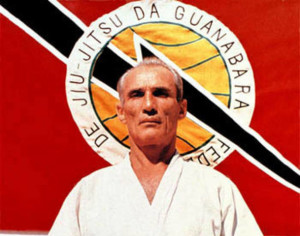 In 1914, jiu-jitsu master Esai Maeda, also known as Count Coma, was given the opportunity to travel to Brazil as part of a large Japanese immigration colony. In Brazil, in the northern state of Para, he befriended Gastão Gracie, an influential businessman, who helped Maeda get established. To show his gratitude, Maeda offered to teach traditional Japanese jiu-jitsu to Gastão’s oldest son, Carlos Gracie. Carlos learned for a few years and eventually passed his knowledge to his brothers.
In 1914, jiu-jitsu master Esai Maeda, also known as Count Coma, was given the opportunity to travel to Brazil as part of a large Japanese immigration colony. In Brazil, in the northern state of Para, he befriended Gastão Gracie, an influential businessman, who helped Maeda get established. To show his gratitude, Maeda offered to teach traditional Japanese jiu-jitsu to Gastão’s oldest son, Carlos Gracie. Carlos learned for a few years and eventually passed his knowledge to his brothers.
Helio Gracie, the youngest son of Gastão and Cesalina Gracie’s eight children (three were girls), was always a very physically frail child. He would run up a flight of stairs and have fainting spells, and no one could figure out why. In fact, upon completing second grade, he convinced his mother that he wasn’t well enough to attend school, anymore. She fell for it, and he never went back to school.
When the family experienced some financial hardships following their move to Rio, some of the children were scattered to live with other relatives. Helio was sent to live with his aunts, and through these family contacts, he found work as a coxswain for a popular local rowing team, eventually moving into the team dorms. His indomitable spirit and great sense of humor combined to make him quite a hell-raiser. In fact, his tireless ability to drive people “nuts,” earned him the nickname of “Caxinguelê” or “Squirrel” in Portuguese.
At age fourteen, he moved in with his older brothers who lived and taught jiu-jitsu in a house in Botafogo, a borough of Rio de Janeiro. Following doctor’s recommendations, Helio would spend the next few years limited to only watching his brothers teach.
One day, when Helio was 16 years old, a student showed up for class when Carlos was not around. Helio, who had memorized all the techniques from watching his brothers teach, offered to start the class. When the class was over, Carlos showed up and apologized for his delay. The student answered, “No problem. I enjoyed the class with Helio very much and, if you don’t mind, I’d like to continue learning from him.” Carlos agreed, and Helio became an instructor.
Helio soon realized that due to his frail physique, most of the techniques he had learned from watching Carlos teach were particularly difficult for him to execute. Eager to make the techniques work for him, he began modifying them to accommodate his weak body. Emphasizing the use of leverage and timing over strength and speed, Helio modified virtually all of the techniques and, through trial and error, created Gracie/Brazilian Jiu-jitsu.
In order to prove the effectiveness of his new system, Helio openly challenged all the reputable martial artists in Brazil. He fought 18 times, including matches against onetime world heavyweight wrestling champion, Wladek Zbyszko and the #2-ranked Judoka in the world at the time, Kato, whom Helio choked unconscious in six minutes. His victory against Kato qualified him to enter the ring with the world champion, Masahiko Kimura, who outweighed Helio by almost 80 pounds.
In an event worthy of a Hollywood movie, he once jumped into the shark-infested waters of the Atlantic Ocean to save a man from drowning. This heroic feat earned him a medal of honor.
At 43 years old, Helio and his opponent, former student Waldemar Santana, set the world record for the longest uninterrupted no-holds-barred fight in history when they fought for an incredible 3 hours and 40 minutes!
Helio widely regarded as the first sports hero in Brazilian history, also challenged boxing icons Primo Carnera, Joe Louis, and Ezzard Charles. They all declined.
A modern-day legend, Helio Gracie gained international acclaim for his dedication to the dissemination of the art and philosophy of Gracie Jiu-jitsu. A dedicated family man who exemplified a healthy life-style, he was the epitome of courage, discipline, determination, and an inspiration to all those who knew him.
